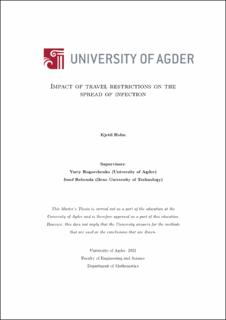Impact of travel restrictions on the spread of infection
| dc.contributor.advisor | Rogovchenko, Yuriy | |
| dc.contributor.advisor | Rebenda, Josef | |
| dc.contributor.author | Holm, Kjetil | |
| dc.date.accessioned | 2022-07-07T16:23:13Z | |
| dc.date.available | 2022-07-07T16:23:13Z | |
| dc.date.issued | 2022 | |
| dc.identifier | no.uia:inspera:109990702:70039473 | |
| dc.identifier.uri | https://hdl.handle.net/11250/3003571 | |
| dc.description.abstract | With the outbreak of Covid-19 it has become more important to know how to deal with a large scale epidemic effectively. Governments utilize different methods to try and contain the spread of viruses, to different results. But what does modeling say about the way to approach the problem? The purpose of the thesis is to introduce a modification of a popular SIR model for the spread of infectious diseases which allows to explore the impact of travel. The group of susceptible individuals S is split into two subgroups in accordance with the travel patterns: S1 (traveling individuals) and S2 (not traveling individuals). Stability properties of infection-free and endemic equilibria are studied with respect to the basic reproduction number. Numerous numerical simulations illustrate the dynamics of the system, including its modifications based on the introduction of the delayed argument. The results of the theoretical analysis and numerical simulations are compared to the recent empirical data to provide practical advice to local and governmental policy makers. | |
| dc.description.abstract | ||
| dc.language | ||
| dc.publisher | University of Agder | |
| dc.title | Impact of travel restrictions on the spread of infection | |
| dc.type | Master thesis |
Tilhørende fil(er)
Denne innførselen finnes i følgende samling(er)
-
Master's theses in Mathematics [19]
MA503
